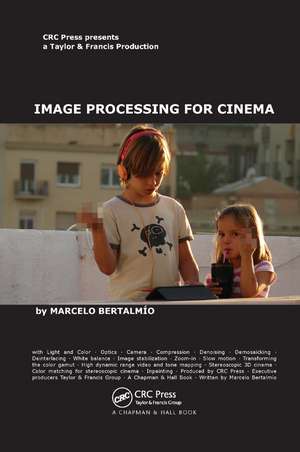Image Processing for Cinema: Chapman & Hall/CRC Mathematical and Computational Imaging Sciences Series
Autor Marcelo Bertalmioen Limba Engleză Paperback – 23 oct 2019
The author focuses on the ideas behind the methods, rather than proofs and derivations. The first part of the text presents fundamentals on optics and color. The second part explains how cameras work and details all the image processing algorithms that are applied in-camera. With an emphasis on state-of-the-art methods that are actually used in practice, the last part describes image processing algorithms that are applied offline to solve a variety of problems.
The book is designed for advanced undergraduate and graduate students in applied mathematics, image processing, computer science, and related fields. It is also suitable for academic researchers and professionals in the movie industry.
Preț: 356.75 lei
Preț vechi: 513.08 lei
-30% Nou
Puncte Express: 535
Preț estimativ în valută:
68.27€ • 74.13$ • 57.35£
68.27€ • 74.13$ • 57.35£
Carte tipărită la comandă
Livrare economică 22 aprilie-06 mai
Preluare comenzi: 021 569.72.76
Specificații
ISBN-13: 9780367378936
ISBN-10: 0367378930
Pagini: 321
Dimensiuni: 156 x 234 mm
Greutate: 0.64 kg
Ediția:1
Editura: CRC Press
Colecția Chapman and Hall/CRC
Seria Chapman & Hall/CRC Mathematical and Computational Imaging Sciences Series
ISBN-10: 0367378930
Pagini: 321
Dimensiuni: 156 x 234 mm
Greutate: 0.64 kg
Ediția:1
Editura: CRC Press
Colecția Chapman and Hall/CRC
Seria Chapman & Hall/CRC Mathematical and Computational Imaging Sciences Series
Cuprins
LIGHTS: Light and Color. Optics. CAMERA: Camera. ACTION: Compression. Denoising. Demosaicking and Deinterlacing. White Balance. Image Stabilization. Zoom-In and Slow Motion. Transforming the Color Gamut. High Dynamic Range Video and Tone Mapping. Stereoscopic 3D Cinema. Color Matching for Stereoscopic Cinema. Inpainting. Bibliography. Index.
Descriere
This book presents a detailed overview of image processing techniques that are used in practice in digital cinema. It shows how image processing has become ubiquitous in movie-making, from shooting to exhibition. The book covers all the ways in which image processing algorithms are used to enhance, restore, adapt, and convert moving images. These techniques and algorithms make the images look as good as possible while exploiting the capabilities of cameras, projectors, and displays.






